Felt B2 (2011)
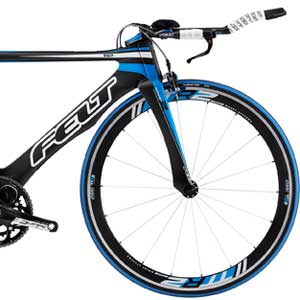
Felt has correctly understood a trend and a truth the rest of the bike industry is slower to grasp: The more the price of a complete bike exceeds $5000, the more Shimano's Di2 electronic groupkit becomes preeminent in the discussion.
Yes, SRAM Red has dominated triathlon and time trial in high-end race results this year. Yes, if a really expensive bike is not Di2 equipped, then it's probably advantage-SRAM. Most of the retailers and manufacturers to whom I've spoken report that their SRAM Red-equipped bikes are doing well.
But Shimano isn't, or shouldn't be, complaining. The hottest groupkit going in triathlon is Ultegra. But this is a kit most often spec'd on complete tri bikes costing from $3000 to $4000. The B2 is a $6500 bike, and Felt's view seems to be that once the complete tri bike hits a price tag of $5000, shift cables don't belong on it.
For this reason, the B2's biggest competitor is its little brother, the $5000 Di2-shifted B10, and if it's an electronically-shifted bike in this $4800 to $6500 price point you want to talk about, few tri bike makers are part of the discussion.
While the most interesting thing Felt did technology-wise from 2010 to 2011 was to introduce a new frame (its DA, the most interesting market move Felt made was the B10. Felt realized that Di2 was even more useful to timed racers (i.e., triathletes) than to road racers, and determined to present a deal that Di2 customers could not refuse.
The existence of the B10 raises this question: Can the B2 complete with it? Is the B2 worth the extra $1500? The frames are identical. The differences between the two models are as follows:
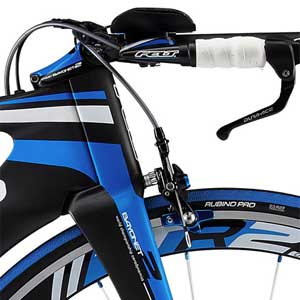
Bayonet 2 versus Aero UHC
The most obvious B2 upgrade over the B10 is the Bayonet 2 fork. Not that triathletes care, but it appeared a real question during the Summer of 2010 whether this fork was going to remain UCI legal. In fact, it is and will be. This is the only bike in Felt's line-up that carries the Bayonet 2, although this fork can be bought and placed on all Felt bikes below this model, down to the B16 if you want.
The Bayonet 2 fork sells aftermarket for between $800 and $900, and Felt claims the adoption of this fork over its standard fork reduces overall bike drag by 10 percent, and also stiffens up the front end considerably. The pertinent questions are these: does the overall drag of the bike + rider aboard decrease correspondingly; and, if not, what's the applied difference in drag between bikes equipped with one fork versus the other?
I don't know the answer. It's going to be "X" pounds, or ounces, or grams, of drag at "Y" miles per hour. When you're spending incremental dollars above $5000, what's a good value in drag savings per dollar at 25mph? $3 per gram? $1 per gram? This sounds like a good topic for our Reader Forum.
Then, does the front end of the bike outfitted with Felt's new Aero UHC (non-Bayonet fork that comes on the B10) need stiffening? I don't know that either. On the one hand, The aerodynamics of this Felt frame were generated around the idea of a 1" steerer, so, yes, the Bayonet is going to be a lot stiffer. On the other hand, this is a timed race bike, not a road race bike. How often are you going to be torquing the front of this bike?
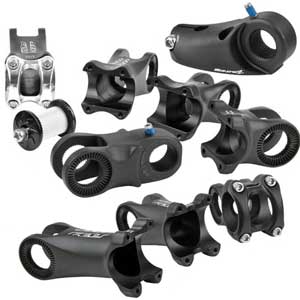
Geometry and Fit
The bikes themselves are fairly middle of the road geometrically, maybe slightly favoring "long and low" (they're more geometrically akin to Cervelo than to, say, Scott or Cannondale). I've written about the geometry of Felt's bikes plenty elsewhere on Slowtwitch.
The Bayonet fork does allow the bike to be really versatile as regards fit. The stems are splined, and can be hinged (the pieces are displayed adjacent). The stems can be pitched at angles as finely grained as the spline's keyways, including a downward pitch. The Bayonet stem can be of a single piece, or a hinged two-piece system that allows for just about any aerobar placement imaginable. While these pieces add a little weight over a typical stem, it's a very functional, well-conceived system, and makes fitting easy for retailers and their customers. Advantage: Bayonet 2.
Cranksets
The second difference between the B2 and the B10 is the crankset. The bike reviewed here comes with FSA's Team Issue crank. The B10 comes with FSA's TriMax forged aluminum crankset.
Both are nice cranks. The TriMax TT crank that comes on the B10 is a very popular, storied crank that FSA contends is the "winningest crank in time trial history." It has the SL-K Light crankarm profile. But, it's the carbon version that has won all these TTs. It's a new version that comes on the B10—a cold forged aluminum crank. It's built with a 110mm bolt pattern, so you can take off these rings if you'd like and spec a smaller set. And, these are FSA's solid (more aero) TT rings.
This is a downspec'd crank that also appears on Felt's B14. Fine. But if somebody has suddenly determined cold forged cranks are yesterday's technology, I didn't get that memo. I like this crank! Advantage: TriMax aluminum.
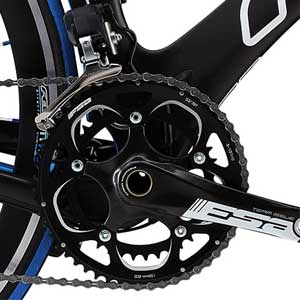
The B2's crank is FSA's Team Issue 2-piece crank, with an integrated MegaExo BB. This is a 130mm bolt pattern crank, which is in my view a downspec for triathlon, but it is a full carbon crank, certainly lighter than the crank spec'd on the B10. That established, I'm not at all convinced this is an upspec from FSA's really neat aluminum TriMax.
Aerobars
Each of these two Felt models comes with Felt's Devox aerobars. Realize that these bars are made of three sub-assemblies: The base/pursuit bar; the armrest cradle and bracket mechanisms; the extensions. Each of these sub-assemblies is made in an aluminum version and a carbon version.
Each sub-assembly style varies a fair bit in weight, with the carbon versions obviously lighter than their aluminum counterparts. There is no difference, however, in the ergonomics or aerodynamics. The one difference in the Devox systems between these two bikes is in the extension: The Devox aerobar system in the B10 is all aluminum, whereas the B2 gets a carbon sub-in on its extensions.
Wheels
The wheels differ as well. Each wheelset on both Felt models is fine. I've gotten good reports from the field attesting to the durability of the hubs, and the complete wheels, that seem to stay in true and in round when sanely ridden (and even when insanely ridden, which one likes to do from time to time, doesn't one?).
The B2 sports a Felt Aero 2 wheelset while B10 must make due with the less aerodynamic Aero 3. Here's where you have to think less about the value of the wheel itself, rather the purpose of the wheel, and your overall intentions with the bike on race day. One might argue that the Aero 3 wheel that comes on the less-expensive B10 is at least as good, assuming you'll use a second set of pure race wheels on race day. Is this not a fair assumption on a $6500 bike?
The only difference between these two wheelsets is the rim, and the only difference in the rim is its shape and depth. The Aero 2 wheel is undeniably, though probably not terrifically, faster than the Aero 3, but, is it not moot if either wheelset is going to get replaced on race day?
This is where the buyer must make a decision: If you're a one-set-of-wheels guy (or gal) the B2's wheelset is an upgrade over the wheelset on the B10. If not, then the wheels on the B2 are not really an upgrade for you.
The take-away
Here's where Felt wins: When the discussion turns to a Di2 bike at a price affordable by the middle class, the decision seems to be between a Felt and a Felt. Yes, there are some luscious Di2-ready frames out there, such as Scott's Plasma TT, Trek's 9-Series Speed Concept frameset, a Specialized Shiv or a Cervelo P4.
Andreas Raelert rode his Blue Triad SL with Di2 in Kona this past year. Craig Alexander used Di2 aboard his Orbea Ordu, and Timo Bracht, shifted electronically aboard his Giant Trinity Advanced, both in Kona and during his win at Ironman Arizona.
Dirk Bockel rides Di2 on his Ceepo Katana, as do Pete Jacobs, Faris Al Sultan and Rachel Joyce on their Storck Aero 2 bikes. Leanda Cave rode Di2 on her Pinarello FT3 to impressive palmares in 2010. Kate Major shifts with Di2 while riding her Wilier Crono.
Still, if you consider all these fine bikes, and tally the cost of each with Di2 spec'd, if the price doesn't phase you you're probably not getting any tax cut from Congress this year. That's what makes Felt unique for 2010. While this company has nothing to apologize for in any of the lower price points, at the upper end it seems to have staked its season on Shimano's delivery of, and customers' interest in, Di2. I can't find any fault with this strategy.



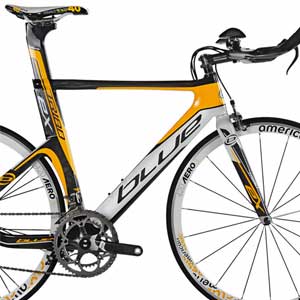
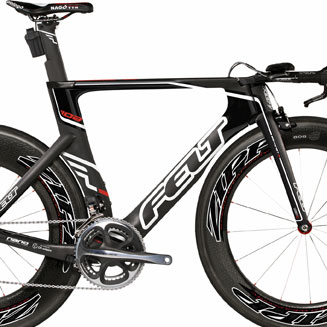

Start the discussion at forum.slowtwitch.com